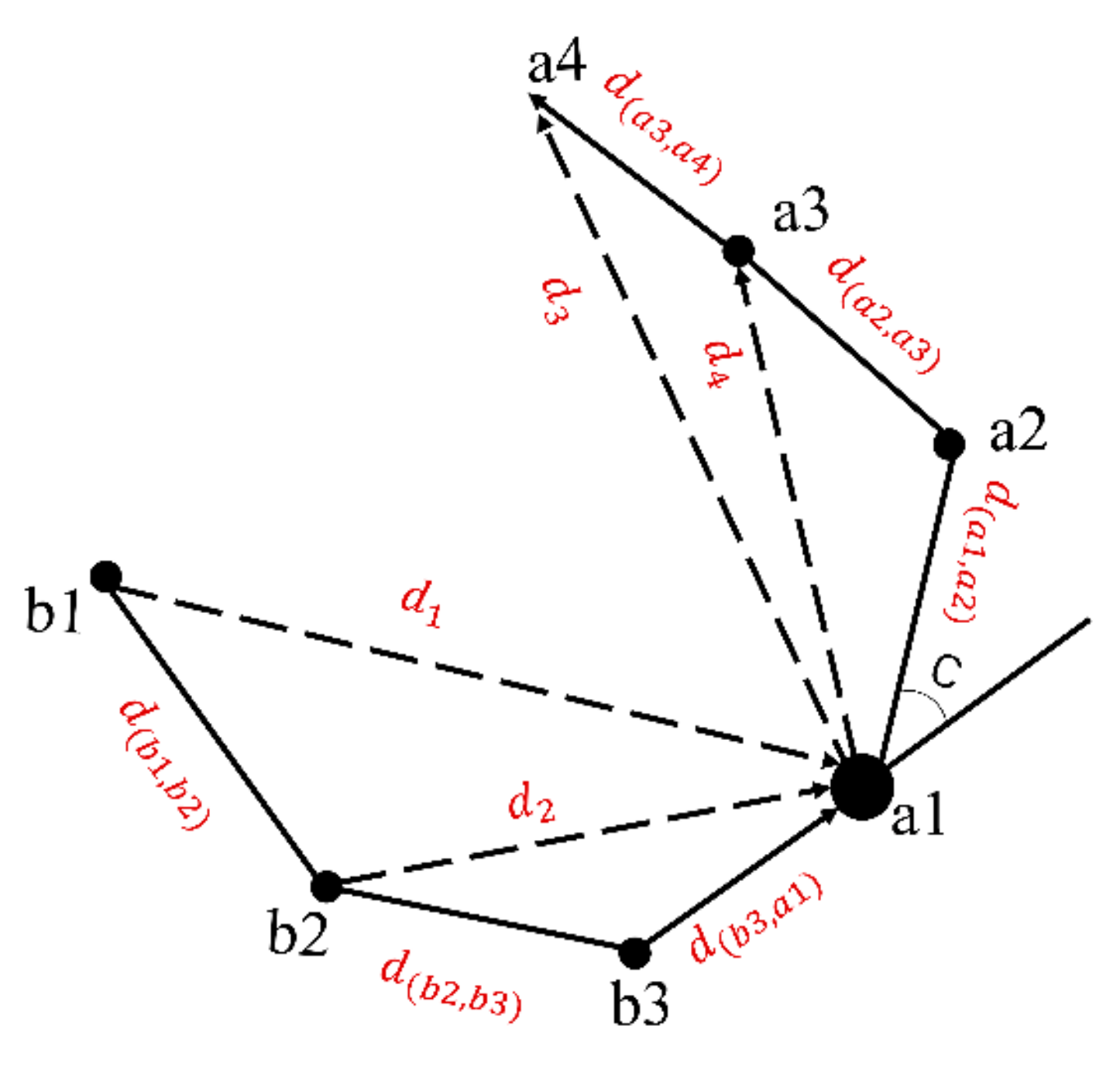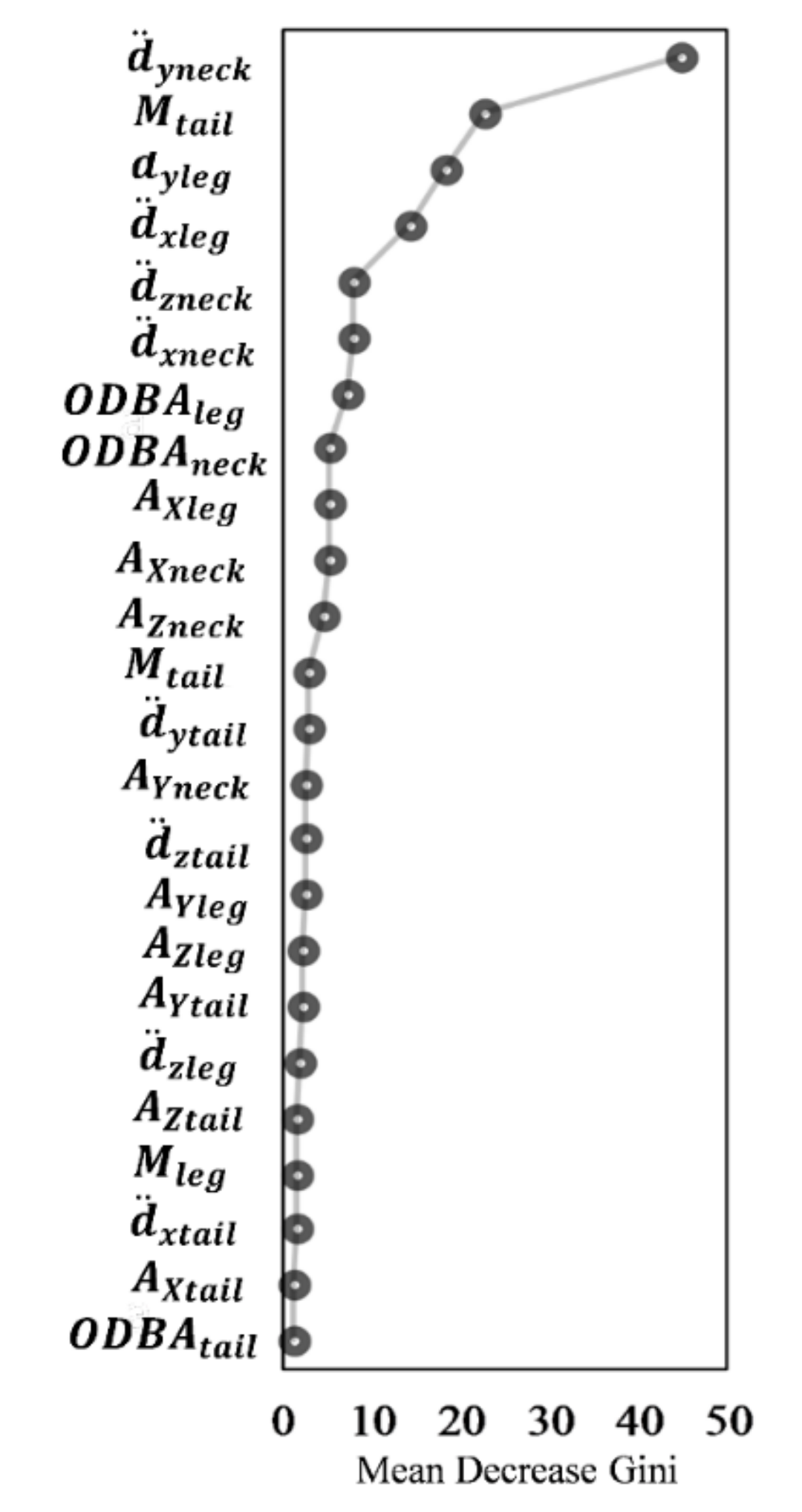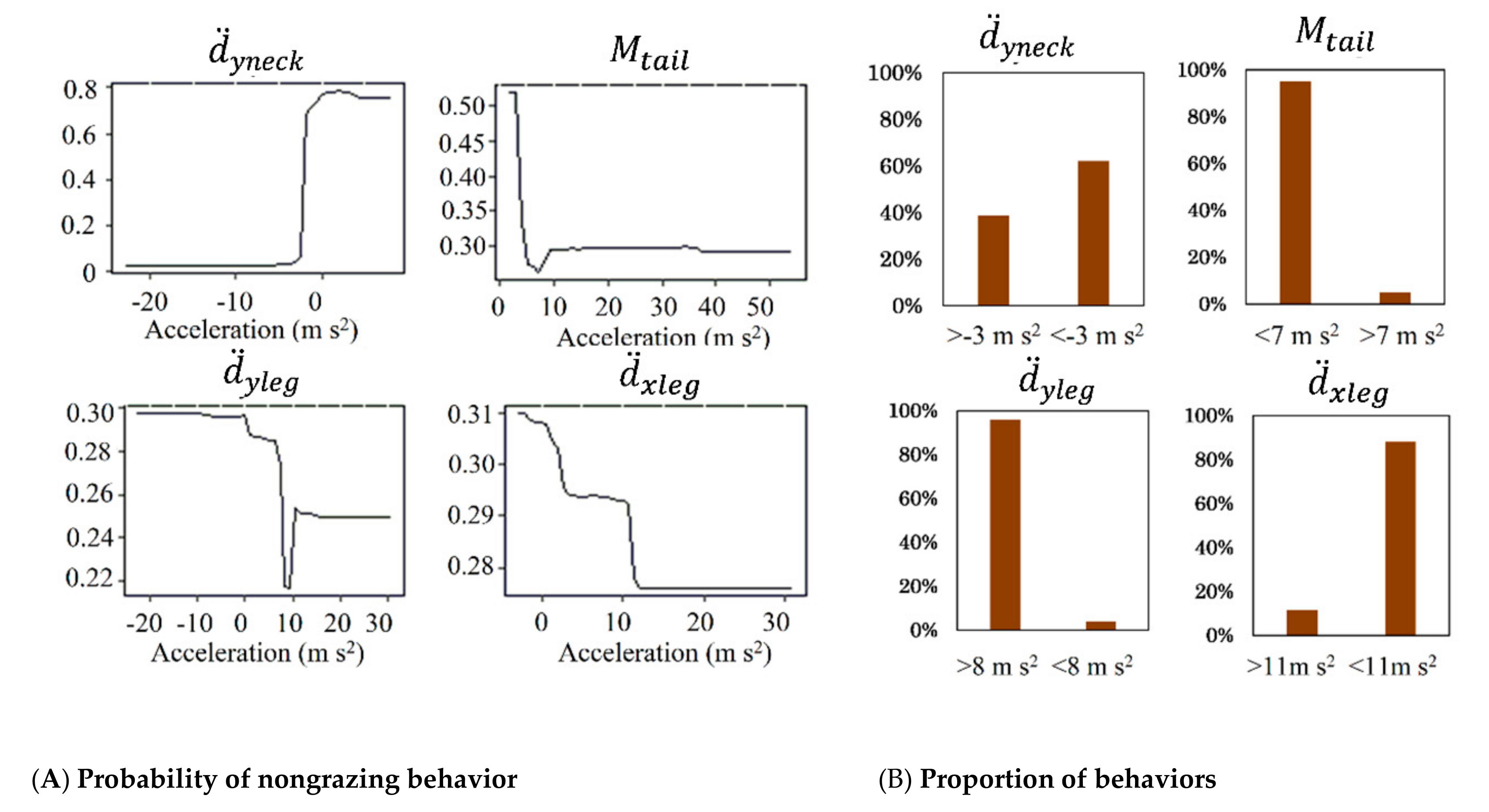Method for Classifying Behavior of Livestock on Fenced Temperate Rangeland in Northern China
Abstract
1. Introduction
2. Materials and Methods
2.1. Equipment and Animals
2.2. Observation of Livestock Behaviors
2.3. Movement Metrics Derived from GPS and Tri-Axis Accelerometer Data
2.4. Livestock Behavior Modelling
- Construct bootstrap data set (bag data set) from approximate 2/3 of the original data set; the remaining 1/3 of the data set is recognized as ‘out of bag’ (OOB).
- Randomly select several predictor variables to calculate nodes in the bootstrap dataset.
- At each decision tree node, test a random subset of predictor variables, to partition the bootstrap data into increasingly homogeneous subsets. The node-splitting variable selected from the variable subset is that which results in the greatest increase in data purity (Gini) before and after the tree node split.
- The trees are fully grown, and each tree is used to predict OOB data, compute accuracy, and average error rates over all predictions.
- The predictions are calculated by means of the majority vote of OOB predictions of the tree, and all predictions are averaged together to determine the class for the observation.
2.5. Performance of the Random Forest Classifier
3. Results
3.1. Performance of GPS, Tri-Axis, and GPS-Tri Axis Models
3.2. Cross-Validation
3.3. Relative Importance of Variables
3.4. Marginal Effect of the Variable on Livestock Behavior Classification
4. Discussion
4.1. Optimal Time Interval for GPS Models
4.2. Model Performance
5. Conclusions
Supplementary Materials
Author Contributions
Funding
Acknowledgments
Conflicts of Interest
References
- Assessment, Millennium Ecosystem. Ecosystems and Human Well-Being; Island Press: Washington, DC, USA, 2005. [Google Scholar]
- Massa, C.; Bichet, V.; Gauthier, É.; Perren, B.B.; Mathieu, O.; Petit, C.; Monna, F.; Giraudeau, J.; Losno, R.; Richard, H. A 2500 year record of natural and anthropogenic soil erosion in South Greenland. Quat. Sci. Rev. 2012, 32, 119–130. [Google Scholar] [CrossRef]
- Okayasu, T.; Okuro, T.; Jamsran, U.; Takeuchi, K. Impact of the spatial and temporal arrangement of pastoral use on land degradation around animal concentration points. Land Degrad. Dev. 2010, 21, 248–259. [Google Scholar] [CrossRef]
- Manthey, M.; Peper, J. Estimation of grazing intensity along grazing gradients–the bias of nonlinearity. J. Arid Environ. 2010, 74, 1351–1354. [Google Scholar] [CrossRef]
- Bailey, D.W.; Gross, J.E.; Laca, E.A.; Rittenhouse, L.R.; Coughenour, M.B.; Swift, D.M.; Sims, P.L. Mechanisms that result in large herbivore grazing distribution patterns. Rangel. Ecol. Manag. J. Range Manag. Arch. 1996, 49, 386–400. [Google Scholar] [CrossRef]
- Anderson, D.M.; Winters, C.; Estell, R.E.; Fredrickson, E.L.; Doniec, M.; Detweiler, C.; Rus, D.; James, D.; Nolen, B. Characterising the spatial and temporal activities of free-ranging cows from GPS data. Rangel. J. 2012, 34, 149–161. [Google Scholar] [CrossRef]
- Li, C.; Hao, X.; Zhao, M.; Han, G.; Willms, W.D. Influence of historic sheep grazing on vegetation and soil properties of a Desert Steppe in Inner Mongolia. Agric. Ecosyst. Environ. 2008, 128, 109–116. [Google Scholar] [CrossRef]
- Fernandez-Gimenez, M.; Allen-Diaz, B. Vegetation change along gradients from water sources in three grazed Mongolian ecosystems. Plant Ecol. 2001, 157, 101–118. [Google Scholar] [CrossRef]
- Scimone, M.; Rook, A.; Garel, J.; Sahin, N. Effects of livestock breed and grazing intensity on grazing systems: 3. Effects on diversity of vegetation. Grass Forage Sci. 2007, 62, 172–184. [Google Scholar] [CrossRef]
- Warren, S.; Thurow, T.; Blackburn, W.; Garza, N. The influence of livestock trampling under intensive rotation grazing on soil hydrologic characteristics. Rangel. Ecol. Manag. J. Range Manag. Arch. 1986, 39, 491–495. [Google Scholar] [CrossRef]
- Lagarde, F.; Guillon, N.; Dubroca, L.; Bonnet, X.; Kaddour, K.B.; Slimani, T.; El Mouden, E. Slowness and acceleration: A new method to quantify the activity budget of chelonians. Anim. Behav. 2008, 75, 319–329. [Google Scholar] [CrossRef]
- Cornou, C.; Lundbye-Christensen, S. Classifying sows’ activity types from acceleration patterns: An application of the multi-process Kalman filter. Appl. Anim. Behav. Sci. 2008, 111, 262–273. [Google Scholar] [CrossRef]
- Martiskainen, P.; Järvinen, M.; Skön, J.-P.; Tiirikainen, J.; Kolehmainen, M.; Mononen, J. Cow behaviour pattern recognition using a three-dimensional accelerometer and support vector machines. Appl. Anim. Behav. Sci. 2009, 119, 32–38. [Google Scholar] [CrossRef]
- González, L.; Bishop-Hurley, G.; Handcock, R.N.; Crossman, C. Behavioral classification of data from collars containing motion sensors in grazing cattle. Comput. Electron. Agric. 2015, 110, 91–102. [Google Scholar] [CrossRef]
- Fahlman, A.; Wilson, R.; Svärd, C.; Rosen, D.A.; Trites, A.W. Activity and diving metabolism correlate in Steller sea lion Eumetopias jubatus. Aquat. Biol. 2008, 2, 75–84. [Google Scholar] [CrossRef]
- Gleiss, A.C.; Dale, J.J.; Holland, K.N.; Wilson, R.P. Accelerating estimates of activity-specific metabolic rate in fishes: Testing the applicability of acceleration data-loggers. J. Exp. Mar. Biol. Ecol. 2010, 385, 85–91. [Google Scholar] [CrossRef]
- Green, J.; Halsey, L.; Wilson, R.; Frappell, P. Estimating energy expenditure of animals using the accelerometry technique: Activity, inactivity and comparison with the heart-rate technique. J. Exp. Biol. 2009, 212, 471–482. [Google Scholar] [CrossRef]
- Halsey, L.G.; Shepard, E.L.; Hulston, C.J.; Venables, M.C.; White, C.R.; Jeukendrup, A.E.; Wilson, R.P. Acceleration versus heart rate for estimating energy expenditure and speed during locomotion in animals: Tests with an easy model species, Homo sapiens. Zoology 2008, 111, 231–241. [Google Scholar] [CrossRef]
- Homburger, H.; Schneider, M.K.; Hilfiker, S.; Lüscher, A. Inferring behavioral states of grazing livestock from high-frequency position data alone. PLoS ONE 2014, 9, e114522. [Google Scholar] [CrossRef]
- Schlecht, E.; Hülsebusch, C.; Mahler, F.; Becker, K. The use of differentially corrected global positioning system to monitor activities of cattle at pasture. Appl. Anim. Behav. Sci. 2004, 85, 185–202. [Google Scholar] [CrossRef]
- De Weerd, N.; van Langevelde, F.; van Oeveren, H.; Nolet, B.A.; Kölzsch, A.; Prins, H.H.; de Boer, W.F. Deriving animal behaviour from high-frequency GPS: Tracking cows in open and forested habitat. PLoS ONE 2015, 10, e0129030. [Google Scholar] [CrossRef]
- Li, Y.; Zhao, X.; Wang, S.; Zhang, F.; Lian, J.; Huang, W.; Mao, W. Carbon accumulation in the bulk soil and different soil fractions during the rehabilitation of desertified grassland in Horqin Sandy Land (Northern China). Pol. J. Ecol. 2015, 63, 88–102. [Google Scholar] [CrossRef]
- Zuo, X.; Zhao, X.; Zhao, H.; Zhang, T.; Guo, Y.; Li, Y.; Huang, Y. Spatial heterogeneity of soil properties and vegetation–soil relationships following vegetation restoration of mobile dunes in Horqin Sandy Land, Northern China. Plant Soil 2009, 318, 153–167. [Google Scholar] [CrossRef]
- Scarnecchia, D.L. The animal-unit and animal-unit-equivalent concepts in range science. Rangel. Ecol. Manag. J. Range Manag. Arch. 1985, 38, 346–349. [Google Scholar] [CrossRef]
- Zuo, X.; Knops, J.; Zhao, X.; Zhao, H.; Zhang, T.; Li, Y.; Guo, Y. Indirect drivers of plant diversity-productivity relationship in semiarid sandy grasslands. Biogeosciences 2012, 9, 1277–1289. [Google Scholar] [CrossRef]
- Wilson, R.P.; White, C.R.; Quintana, F.; Halsey, L.G.; Liebsch, N.; Martin, G.R.; Butler, P.J. Moving towards acceleration for estimates of activity-specific metabolic rate in free-living animals: The case of the cormorant. J. Anim. Ecol. 2006, 75, 1081–1090. [Google Scholar] [CrossRef]
- Shepard, E.L.; Wilson, R.P.; Quintana, F.; Laich, A.G.; Liebsch, N.; Albareda, D.A.; Halsey, L.G.; Gleiss, A.; Morgan, D.T.; Myers, A.E. Identification of animal movement patterns using tri-axial accelerometry. Endanger. Species Res. 2008, 10, 47–60. [Google Scholar] [CrossRef]
- Evans, J.S.; Cushman, S.A. Gradient modeling of conifer species using random forests. Landsc. Ecol. 2009, 24, 673–683. [Google Scholar] [CrossRef]
- Breiman, L. Random forests. Mach. Learn. 2001, 45, 5–32. [Google Scholar] [CrossRef]
- Mouton, A.M.; De Baets, B.; Goethals, P.L. Ecological relevance of performance criteria for species distribution models. Ecol. Model. 2010, 221, 1995–2002. [Google Scholar] [CrossRef]
- Cutler, D.R.; Edwards, T.C., Jr.; Beard, K.H.; Cutler, A.; Hess, K.T.; Gibson, J.; Lawler, J.J. Random forests for classification in ecology. Ecology 2007, 88, 2783–2792. [Google Scholar] [CrossRef]
- Shoukri, M.; Martin, S. Estimating the number of clusters for the analysis of correlated binary response variables from unbalanced data. Stat. Med. 1992, 11, 751–760. [Google Scholar] [CrossRef] [PubMed]
- Augustine, D.; Derner, J. Assessing herbivore foraging behavior with GPS collars in a semiarid grassland. Sensors 2013, 13, 3711–3723. [Google Scholar] [CrossRef] [PubMed]
- Scheibe, K.M.; Gromann, C. Application testing of a new three-dimensional acceleration measuring system with wireless data transfer (WAS) for behavior analysis. Behav. Res. Methods 2006, 38, 427–433. [Google Scholar] [CrossRef] [PubMed]
- Hepworth, K.; Test, P.; Hart, R.; Waggoner, J.; Smith, M. Grazing systems, stocking rates, and cattle behavior in southeastern Wyoming. Rangel. Ecol. Manag. J. Range Manag. Arch. 1991, 44, 259–262. [Google Scholar] [CrossRef]







| Behavior category | Definition | Explanation |
|---|---|---|
| Grazing | Foraging, Foraging–walking | Foraging: foraging continuously (head lowered) Foraging–walking: foraging while walking (head raised and lowered) |
| Nongrazing | Standing, Lying down, Rumination | Standing: the animal stands on all four legs, with head erect and without swinging its head from side to side Lying down: the cattle lies on the ground in any position (except flat on its side) without ruminating Ruminating: the cattle lies in a stall masticating regurgitated feed, swallowing masticated feed, or regurgitating feed with head erect |
| Observed Behaviors | Predicted Behaviors | ||||||||
|---|---|---|---|---|---|---|---|---|---|
| Grazing | Nongrazing | Percent Accuracy | Grazing | Nongrazing | Percent Accuracy | Grazing | Nongrazing | Percent Accuracy | |
| 100 s | 150 s | 200 s | |||||||
| Grazing | 421 | 35 | 0.92 | 428 | 28 | 0.94 | 428 | 28 | 0.94 |
| Nongrazing | 66 | 17 | 0.20 | 63 | 20 | 0.24 | 51 | 32 | 0.39 |
| 250 s | 300 s | 350 s | |||||||
| Grazing | 427 | 29 | 0.94 | 430 | 26 | 0.94 | 433 | 23 | 0.95 |
| Nongrazing | 44 | 39 | 0.47 | 30 | 53 | 0.64 | 34 | 49 | 0.59 |
| 400 s | 450s | 500 s | |||||||
| Grazing | 447 | 9 | 0.98 | 440 | 16 | 0.96 | 446 | 10 | 0.98 |
| Nongrazing | 33 | 50 | 0.60 | 31 | 52 | 52 | 35 | 48 | 0.58 |
| 550 s | 600 s | 650 s | |||||||
| Grazing | 446 | 10 | 0.98 | 444 | 12 | 0.97 | 445 | 11 | 0.98 |
| Nongrazing | 35 | 48 | 0.59 | 33 | 50 | 0.6 | 32 | 51 | 0.61 |
| 700 s | 750 s | 800 s | |||||||
| Grazing | 442 | 14 | 0.97 | 440 | 15 | 0.96 | 435 | 21 | 0.95 |
| Nongrazing | 32 | 51 | 0.61 | 28 | 55 | 0.66 | 29 | 56 | 0.66 |
| Observed Behaviors | Predicted Behaviors | ||
|---|---|---|---|
| Grazing | Nongrazing | Accuracy | |
| Grazing | 447 | 9 | 0.98 |
| Nongrazing | 7 | 76 | 0.92 |
© 2019 by the authors. Licensee MDPI, Basel, Switzerland. This article is an open access article distributed under the terms and conditions of the Creative Commons Attribution (CC BY) license (http://creativecommons.org/licenses/by/4.0/).
Share and Cite
Gou, X.; Tsunekawa, A.; Peng, F.; Zhao, X.; Li, Y.; Lian, J. Method for Classifying Behavior of Livestock on Fenced Temperate Rangeland in Northern China. Sensors 2019, 19, 5334. https://doi.org/10.3390/s19235334
Gou X, Tsunekawa A, Peng F, Zhao X, Li Y, Lian J. Method for Classifying Behavior of Livestock on Fenced Temperate Rangeland in Northern China. Sensors. 2019; 19(23):5334. https://doi.org/10.3390/s19235334
Chicago/Turabian StyleGou, Xiaowei, Atsushi Tsunekawa, Fei Peng, Xueyong Zhao, Yulin Li, and Jie Lian. 2019. "Method for Classifying Behavior of Livestock on Fenced Temperate Rangeland in Northern China" Sensors 19, no. 23: 5334. https://doi.org/10.3390/s19235334
APA StyleGou, X., Tsunekawa, A., Peng, F., Zhao, X., Li, Y., & Lian, J. (2019). Method for Classifying Behavior of Livestock on Fenced Temperate Rangeland in Northern China. Sensors, 19(23), 5334. https://doi.org/10.3390/s19235334






